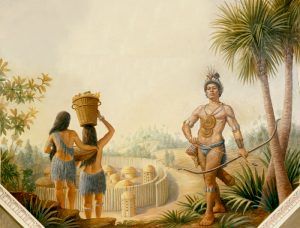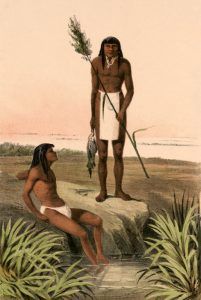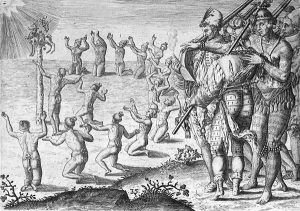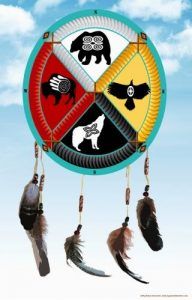Summaries: A B C D E-I J-K L-M N O P Q-R S T-V W X-Z
Tacatacuru – The Tacatacuru were a Timucuan tribe who lived on Cumberland Island in Georgia in the 16th and 17th centuries.
Tachi – One of the larger tribes of the Yokut Indians, they lived on the plains north of Tulare Lake in south-central California. By the early 1900s, they had been reduced to only a few dozen survivors.
Tohono O’odham – The Tohono O’odham people, also called the Papago, are a Native American tribe of the Sonoran Desert who primarily live in Arizona and the Mexican state of Sonora. When the Spanish came upon them, they called them Papago or Pima, but the people rejected this name and officially changed it to Tohono O’odham in the 1980s.
Takelma – Their name means “those dwelling along the river,” as they first occupied the middle portion of the course of the Rogue River in southwest Oregon. Culturally they were closely allied to the Shasta Indians of northern California, with whom they frequently intermarried. Their main dependence on food sources was acorns, which they boiled into mush and gathered roots, seeds, and berries. Tobacco was the only plant they cultivated. Of animal foods, they fished primarily for salmon and hunted deer. They lived in timer houses partly underground with a raised door from which the entrance was made on a ladder. Their numbers were dramatically reduced in the Rogue River War, and by the early 1900s, those few survivors were residing on the Siletz Reservation in Oregon.
Tanoan Family – A linguistic family consisting of the Tewa, Tano, Tigua, Jemez, and Piro groups of Pueblo Indians, who dwelt in various substantial villages on and near the Rio Grande in New Mexico. Of these groups, the Tano and Piro are extinct, and the Jemez includes the remnant of the former inhabitants of Pecos.
Tatavium/Alliklik – The Tatavium were once called the Alliklik by their neighbors, but the tribe prefers Tatavium, which means “People facing the Sun.” They were a branch of the Fernandeno tribe that lived in Southern California. They traditionally occupied an area in northwest present-day Los Angeles County and southern Ventura County, primarily in the upper basin of the Santa Clara River, the Santa Susana Mountains, and the Sierra Pelona Mountains. They lived on the upper Santa Clara River in several villages along with the Serrano, Vanyume, and Kitanemuk in 1770, numbered about 3,500. They had been reduced to about 150 by the early 1900s. They are still a distinct tribe today, with their headquarters in San Fernando, California.
Tewa – Their name means “moccasins,” the Tewa are a group of Pueblo tribes belonging to the Tanoan linguistic family, who historically made their homes on or near the Rio Grande north of Santa Fe, New Mexico.
Timucuan Family – The Timucua were the Native American people living in the Northeast and North Central portions of what is now Florida. The Timucua probably numbered 200,000 and 300,000 people organized into various chiefdoms speaking a common language. The earliest evidence of their presence dates from around 3000 BC.
Tionontati – The tribe, numbering around 8,000 in the 1600s, occupied the highlands south and west of Nottawasaga Bay, extending west to the southeastern shores of Lake Huron in Ontario. After a series of epidemics swept the area during the 1630s, only 3,000 Tionontati in nine villages had survived by 1640. About 1,000 Huron and Tionontati escaped the Iroquois in 1650 and reached temporary safety on Mackinac Island (Upper Michigan). The remainder of the Tionontati were either killed or captured and later adopted into the Iroquois. The mixed Huron-Tionontati group that escaped became known afterward as the Wyandot.
Tiwa/Tigua – A group of Tanoan Pueblo tribes that live in three geographic regions, including Taos and Picuris in northeast New Mexico, Sandia and Isleta near Albuquerque, New Mexico, and at Isleta del Sur, near El Paso, Texas. They fought in the Tiguex War in 1540 and the Pueblo Revolt in 1680. The Tiwa still live at the Isleta, Picuris, Sandia, and Taos Pueblos in New Mexico and in and around El Paso, Texas.
Tlingit – Their name for themselves is Lingít, meaning “people.” The tribe once controlled all the land that extends more than 500 miles from Yakutat Bay to the British Columbia border south of present-day Ketchikan, Alaska. Today, the Yakutat Tlingit Tribe is a federally recognized Indian tribe in Yakutat, Alaska, with over 450 tribal members.
Towa – One of three Kiowa-Tanoan languages spoken by the Pueblo people of New Mexico, it is also known as Jamez, after the only pueblo where it is still spoken. Though the three Kiowa-Tanoan languages spoken by the Pueblo people are closely related, speakers of one cannot fully understand speakers of another. In 1838, the Jemez culture diversified when the Towa-speaking people from the Pueblo of Pecos resettled at the Pueblo of Jemez to escape the increasing depredations of the Spanish and Comanche cultures. The Pecos culture was rapidly integrated into the Jemez Society, and in 1936, both cultural groups were legally merged into one by an Act of Congress. The Pecos culture still survives at Jemez, and its traditions have been preserved. Jamez traditional law forbids the language from being translated into writing to prevent exploitation by outside cultures. As about 90% of the tribal Jemez members speak the language, it is not considered to be extremely endangered.
Umatilla – A Sahaptin-speaking tribe lived on the Columbia River Plateau in northeastern Oregon and southeastern Washington. They were included under the Walla Walla by Lewis and Clark in 1805, though their language is distinct. Because the Umatilla were frequently raided by neighboring Paiute, they were terrified when the Lewis and Clark Expedition approached them. However, determined to placate them, Clark forced his way into one of the lodges and convinced the inhabitants of his goodwill through the liberal distribution of gifts. The Umatilla depended on the great numbers of salmon found in the rivers for food and trade, even using the dried fish for fuel. In 1855 they joined in a treaty with the United States and settled on the Umatilla Reservation in eastern Oregon. Today, the Umatilla share the land and a governmental structure with the Cayuse and the Walla Walla tribes as part of the Confederated Tribes of the Umatilla Indian Reservation. The reservation is located near Pendleton, Oregon, near the Blue Mountains.
Ute – Of Shoshonean linguistic stock, the Ute occupied the Four Corners region formerly ruled by the Anasazi, a close relative of the Shoshone Indians. The Ute lived in small groups, mainly familial units, and were a gatherer tribe. It wasn’t until the 1800s, when the Ute acquired the horse that they would become hunters. The state of Utah is named after the Ute.
© Kathy Alexander/Legends of America, updated May 2023.
Summaries: A B C D E-I J-K L-M N O P Q-R S T-V W X-Z
Also See:
Native American Heroes & Leaders




